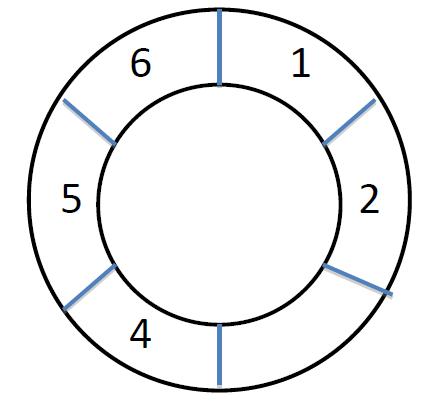Robot
Time Limit: 8000/4000 MS (Java/Others) Memory Limit: 102400/102400 K (Java/Others)
Total Submission(s): 3851 Accepted Submission(s): 1246
Problem Description
Michael has a telecontrol robot. One day he put the robot on a loop with n cells. The cells are numbered from 1 to n clockwise.

At first the robot is in cell 1. Then Michael uses a remote control to send m commands to the robot. A command will make the robot walk some distance. Unfortunately the direction part on the remote control is broken, so for every command the robot will chose a direction(clockwise or anticlockwise) randomly with equal possibility, and then walk w cells forward.
Michael wants to know the possibility of the robot stopping in the cell that cell number >= l and <= r after m commands.

At first the robot is in cell 1. Then Michael uses a remote control to send m commands to the robot. A command will make the robot walk some distance. Unfortunately the direction part on the remote control is broken, so for every command the robot will chose a direction(clockwise or anticlockwise) randomly with equal possibility, and then walk w cells forward.
Michael wants to know the possibility of the robot stopping in the cell that cell number >= l and <= r after m commands.
Input
There are multiple test cases.
Each test case contains several lines.
The first line contains four integers: above mentioned n(1≤n≤200) ,m(0≤m≤1,000,000),l,r(1≤l≤r≤n).
Then m lines follow, each representing a command. A command is a integer w(1≤w≤100) representing the cell length the robot will walk for this command.
The input end with n=0,m=0,l=0,r=0. You should not process this test case.
Each test case contains several lines.
The first line contains four integers: above mentioned n(1≤n≤200) ,m(0≤m≤1,000,000),l,r(1≤l≤r≤n).
Then m lines follow, each representing a command. A command is a integer w(1≤w≤100) representing the cell length the robot will walk for this command.
The input end with n=0,m=0,l=0,r=0. You should not process this test case.
Output
For each test case in the input, you should output a line with the expected possibility. Output should be round to 4 digits after decimal points.
Sample Input
3 1 1 2
1
5 2 4 4
1
2
0 0 0 0
Sample Output
0.5000
0.2500
Source
题意:给出一个环,上面分成n个区域,分别编号为1~n,有一个指针,刚开始的时候指向1的位置
现在有m个操作,每一个操作输入一个w,指针转动w个单位,顺时针转,和逆时针转的概率都是0.5,
现在问m个操作后,指针指向区间[l,r]的概率是多少
dp[i][j]表示第i个命令后,指针指向区域j的概率
这里命令数m很大,而我们递推的时候只需要保存前面一个的状态,所以i%2,节省空间。

1 #include<cstdio> 2 #include<cstring> 3 4 using namespace std; 5 6 double dp[2][210]; 7 8 int main() 9 { 10 int n,m,l,r; 11 while(scanf("%d%d%d%d",&n,&m,&l,&r)) 12 { 13 if(!n&&!m&&!l&&!r) 14 break; 15 memset(dp,0,sizeof dp); 16 dp[0][1]=1.0; 17 int w; 18 int a,b; 19 for(int i=1;i<=m;i++) 20 { 21 scanf("%d",&w); 22 for(int j=1;j<=n;j++) 23 { 24 a=j-w; 25 if(a<1) 26 a+=n; 27 b=j+w; 28 if(b>n) 29 b-=n; 30 dp[i%2][j]=dp[(i-1)%2][a]*0.5+dp[(i-1)%2][b]*0.5; 31 } 32 } 33 double ans=0.0; 34 int mm=m%2; 35 for(int i=l;i<=r;i++) 36 ans+=dp[mm][i]; 37 38 printf("%.4f ",ans); 39 } 40 return 0; 41 }
